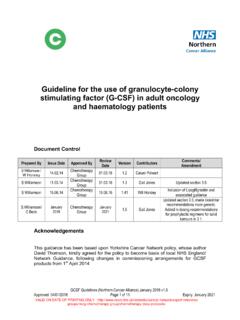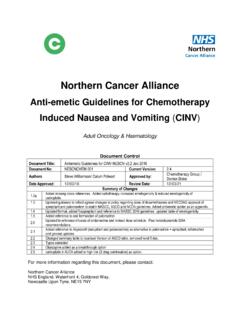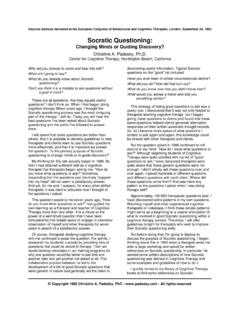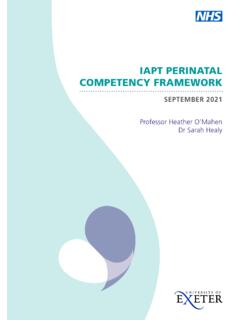Transcription of Northern England Clinical Networks Palliative and End of ...
1 Palliative andEnd of Life CareGuidelinesSymptom control for cancerand non-cancer patientsFourth edition: 2016 Next review date: 2021 Northern EnglandClinical NetworksNORTH OF England CANCER NETWORK Palliative CARE GUIDELINESPALLIATIVE AND END OF LIFE CARE GUIDELINES - Fourth Edition 2016 FOREWORDW elcome to the fourth edition of the Northern England Clinical Networks Palliative and End of LifeCare Guidelines. To ensure that the fourth edition continues to be useful, we surveyed Clinical stafffrom primary and secondary care teams across the North East of England and North Cumbria whoused the third edition. We received considerable valuable feedback and have taken this intoconsideration, removing sections which were thought to be repetitive or rarely used, and addingguidance which was felt to be more has always been the intention that this guidelines booklet should be small, simple and accessible,and present a consensus view on symptom management based on available evidence and expertopinion.
2 The guidelines are not intended to replace excellent textbooks and formularies thatalready guidelines have been written for any clinician responsible for the management and treatmentof patients with Palliative and end of life care needs, regardless of note that drug dose guidance and especially the stated relative potencies of differentopioid drugs is drawn from the Palliative Care Formulary Fifth Edition (PCF5). Where therecommendations differ from the BNF we have tried to highlight this in the use of drugs beyond licence ( off-label ) in Palliative care and pain management practice iscurrently both necessary and common and should be seen as a legitimate aspect of Clinical practice.(See PCF5, pages xix-xxiv)Guidelines are a place to begin. They cannot replace specialist advice from experiencedclinicians. Fundamental to the practice of Palliative care is an emphasis on individualised carefor the symptoms fail to respond to usual measures, or if you are concerned that the guidance givenhere may not be appropriate to the Clinical situation, please contact your local specialistpalliative care team.
3 We are immensely grateful to the effort and commitment made by section authors and editorialteam. The contributors to this edition are medical, nursing and pharmacy colleagues working inprimary and secondary care across our region. With their support, and the enormous assistance ofthe Northern England Clinical Networks , the fourth edition has been successfully we welcome interest from other network groups who may consider adopting aspects ofthese guidelines with appropriate acknowledgment of further information, please visit Alexa ClarkChair, NECN Guidelines Review GroupDr Alex NicholsonCo-chair, NECN Guidelines Review GroupINDEX Palliative Care .. 1 Pain .. 2 Using Adjuvant Analgesic Drugs in Palliative 3 Using Opioids for Pain in Palliative Care .. 4 Opioid Dose Conversion Chart .. 8 Nausea and Vomiting .. 9 Constipation .. 11 Emergencies - Bowel Obstruction .. 12 Emergencies Seizures.
4 13 Emergencies Metastatic Spinal Cord Compression (MSCC) .. 14 Emergencies Malignant Hypercalcaemia .. 15 Emergencies Major Haemorrhage .. 16 Emergencies Malignant Superior Vena Cava Obstruction .. 17 Emergencies - Opioid Toxicity .. 17 Corticosteroids in Palliative Care .. 18 Control of Glucose in Patients on Corticosteroids .. 19 Care in the Last Days of Life .. 20 Diabetes Management at the End of Life .. 21 Pain at the End of Life .. 22 Pain at the End of Life in Renal Impairment .. 23 Pain at the End of Life Supplementary Information .. 24 Nausea and/or Vomiting at the End of Life .. 25 Restlessness, Agitation and/or Delirium at the End of Life .. 26 Respiratory Tract Secretions at the End of Life .. 27 Breathlessness at the End of Life .. 28 Syringe Drivers and Drug Compatibility Chart .. 29 KEY RESOURCES Twycross R, Wilcock A, Howard P (eds) (2014) Palliative Care Formulary.
5 5th Ltd., Nottingham. BNF 70 (September 2015) BMJ Group and Pharmaceutical Press, USED ABBREVIATIONSNORTH OF England CANCER NETWORK Palliative CARE GUIDELINESPALLIATIVE AND END OF LIFE CARE GUIDELINES - Fourth Edition 2016BD - twice dailyMR - modified releaseeGFR - estimated glomerular filtration rate NSAID -non-steroidal anti-inflammatory drugEMA - European Medicines AgencyON - at nightGI - gastrointestinalPO - by mouthGMC - General Medical CouncilPPI - proton pump inhibitorhr(s) - hour(s)PRN - as requiredhrly - hourlyQDS - four times dailyIR - immediate releaseSC - subcutaneousMCA - Mental Capacity ActSPCT - specialist Palliative care team mg - milligramsTENS - transcutaneous electrical nerveMHRA - Medicines and Healthcare productsstimulationRegulatory AgencyTDS - three times dailymin(s) - minute(s)UTI - urinary tract infectionmL - millilitresWHO - World Health Organisationmmol/L - millimoles per litreUTI - urinary tract infectionPALLIATIVE CAREThe World Health Organisation (WHO 1996) defined Palliative care as: the active, holistic care of patients with advanced, progressive illness.
6 Management of pain andother symptoms and provision of psychological, social and spiritual support is paramount. Thegoal of Palliative care is achievement of the best quality of life for patients and their families. The principles of Palliative care are relevant to patients with both malignant and non-malignantdisease and may be relevant to patients from early in their disease trajectory. Palliative care may berequired from the time of diagnosis. It may be delivered in conjunction with disease-modifyingtreatment, and usually becomes a more important part of management as the disease principles of symptom management Detailed assessment in partnership with patient and carers Diagnose cause of symptom(s) using knowledge of pathophysiology and disease processes Investigations and treatment should be appropriate to the stage of disease and prognosis,balancing benefit and harm (as defined by the patient)
7 Choose the most appropriate treatment for the individual balancing benefit against side effectburden and considering factors such as route of administration Avoid making too many changes at once or review will be complexCare planning and decision makingIn Palliative care it is hugely important to be open to, and to consider, future health problems andto plan care to support a patient s wishes and minimise distress. An excellent resource forsupporting decision making is Deciding Right, a North East initiative for making care decisions inadvance. See aspects of Deciding Right, reproduced directly from the web-site, are that it: applies to all ages, care situations and settings emphasises the partnership between the individual, carer or parent and the clinician places the Mental Capacity Act (MCA) at the centre of shared decision-making enables professionals and organisations to comply with the MCA by filling the gap in practice,not just the knowledge gap recognises the individual with capacity as key to making care decisions in advance empowers the individual who lacks capacity to have decisions made in their best interests enables information to be recognisable in all care settings introduces emergency health care plans as an important adjunct in all settings to tailor care tothe individual with complex needs ensures that, wherever possible, documentation and information is suitable for all ages(children, young people and adults).
8 1 Palliative AND END OF LIFE CARE GUIDELINES - Fourth Edition 20162 PAINThe concept of TOTAL PAIN is commonly used in Palliative Care to prompt health professionals to consider all possible influences on the pain experience: Palliative AND END OF LIFE CARE GUIDELINES - Fourth Edition 2016 Careful initial assessment is very important and should include clear documentation of findings. This allows theassessing clinician, and others, to compare progress in management against the early features. Many painschange with time and frequent reassessment is necessary, especially during and after interventions. Multiplesites and/or types of pain are common. EACH pain should be assessed, documented, managed and may be used to record site and radiation of pains, and associated Clinical findings. Pain scores or scales,although subjective, allow the patient to rate the severity of pain and review effectiveness of pain should be assessed for: site, severity, radiation and characteristics of its timing/frequency/variation quality, using descriptive terms ( burning, tingling, throbbing, etc) exacerbating and relieving factors including the effects of drug and non-drug interventions associated symptoms and patient s understanding, fears and concerns, previous experience of pain and expectations of treatment,and other aspects relevant to social, psychological and spiritual care, should be examination should be performed to assist in determining the likely type and cause of pain.
9 Relevantinvestigation, appropriate to the patient s condition, should be considered. This might include biochemistry(which may influence drug choice) and X- it is essential to try to determine the CAUSE of the pain to guide managementPHYSICALTOTAL PAINSOCIALSPIRITUAL Use the oral route wherever possible. Use a non-oral route if necessary, dysphagia, vomiting, bowel obstruction, terminal phase. Prescribe regularly at a dosing interval appropriate to the formulation. Prescribe analgesia as required for breakthrough pain that may occur despite regular guidancePain is an unpleasant sensory and emotional experience associated with actual or potentialtissue damage. It is a highly subjective definition: pain is what the patient says hurts PSYCHOLOGICAL Review, review, review Success in pain management depends upon regular review of pain and its causes, theeffectiveness of the treatment and its acceptability to the on seeking advice from the Specialist Palliative Care Team (SPCT)SPCTs are experienced in the management of complex pain and will offer advice on the use of standard,adjuvant and non-drug measures to manage pain or will consult with the patient for assessment,treatment and review.
10 The following situations warrant referral: complex or multiple pains where assessment is difficult pain that appears resistant to usual measures difficulty with management caused by adverse effects of medication pain associated with more than usual distress, particularly where non-physical factors are in doubt, please ask your local SPCT for AND END OF LIFE CARE GUIDELINES - Fourth Edition 2016 USING ADJUVANT ANALGESIC DRUGS IN Palliative CAREA step-wise approach ( WHO analgesic ladder) provides a framework for Palliative pain management(see p4).Adjuvant analgesic drugsmay be used alongside any step. An adjuvant analgesic is a drug whose primaryindication is for something other than pain, but which has analgesic effects in some painful conditions.*See section below on neuropathic painAdditional approachesto pain relief will be dictated by Clinical circumstances: Interventional methods- spinal analgesia, nerve block, radiotherapy, surgical stabilisation.









